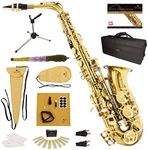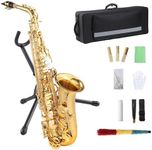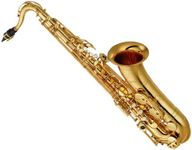Buying Guide for the Best Saxophones
Choosing the right saxophone can be a rewarding experience, but it requires some understanding of the key specifications that differentiate one model from another. Whether you are a beginner, intermediate, or advanced player, knowing what to look for will help you make an informed decision. Here are some important factors to consider when selecting a saxophone.Type of SaxophoneSaxophones come in various types, including soprano, alto, tenor, and baritone. Each type has a different size and pitch range. Soprano saxophones are the smallest and have the highest pitch, while baritone saxophones are the largest and have the lowest pitch. Alto and tenor saxophones are the most common and are often recommended for beginners. Your choice should depend on the type of music you want to play and your physical comfort with the instrument.
MaterialMost saxophones are made of brass, but the finish can vary, including lacquer, silver plating, or gold plating. The material and finish can affect the instrument's durability, weight, and sound quality. Lacquered brass is common and provides a warm sound, while silver plating can offer a brighter tone. Gold plating is often used for its aesthetic appeal and can slightly enhance the richness of the sound. Consider what sound quality you prefer and how much maintenance you are willing to perform.
Key MechanismThe key mechanism refers to the design and placement of the keys on the saxophone. A well-designed key mechanism allows for smooth and comfortable playing. Beginners should look for saxophones with keys that are easy to reach and press. Intermediate and advanced players might prefer more complex key mechanisms that offer greater control and responsiveness. Try out different models to see which key mechanism feels most comfortable for your hands.
MouthpieceThe mouthpiece is a crucial part of the saxophone that greatly influences the sound. Mouthpieces come in various shapes and sizes, and the choice of mouthpiece can affect the ease of play and the tone produced. Beginners should start with a standard mouthpiece that offers a good balance of ease and sound quality. As you progress, you might experiment with different mouthpieces to find one that suits your playing style and desired sound.
ReedThe reed is a thin piece of cane that vibrates to produce sound when you blow into the mouthpiece. Reeds come in different strengths, usually measured on a scale from 1 (soft) to 5 (hard). Softer reeds are easier to play and are recommended for beginners, while harder reeds offer more control and are preferred by advanced players. Your choice of reed strength should match your skill level and the type of music you play.
Brand and ModelDifferent brands and models of saxophones can vary significantly in quality, sound, and price. Well-known brands often have a reputation for producing reliable and high-quality instruments. Researching reviews and seeking recommendations from experienced players or teachers can help you identify reputable brands and models. Try to play-test several saxophones to find one that feels and sounds right for you.





















